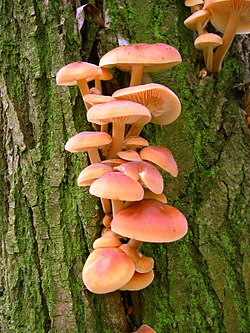Flammulina filiformis
| Flammulina | |
|---|---|

| |
| Cultivated Flammulina velutipes | |

| |
| Wild Enokitake, Flammulina velutipes | |
| Scientific classification | |
| Kingdom: | |
| Division: | |
| Class: | |
| Order: | |
| Family: | |
| Genus: | Flammulina
|
| Species | |
|
Flammulina callistosporioides | |
| Flammulina velutipes | |
|---|---|
| Gills on hymenium | |
| Cap is convex | |
| Hymenium is adnexed | |
| Stipe is bare | |
| Spore print is white | |
| Ecology is saprotrophic | |
| Edibility is choice | |
Enokitake (Chinese: 金針菇, Pinyin: jīnzhēngū;Japanese: えのき茸 enokitake; Korean: 팽이버섯, Revised Romanization: pengi beoseot) are long, thin white mushrooms used in Asian cuisines, particularly those of China, Japan and Korea. These mushrooms are cultivars of Flammulina velutipes also called golden needle mushroom. Wild forms differing in color, texture, and sliminess are called winter mushrooms, velvet foot, or velvet stem among other names.
The mushroom is available fresh or canned, the fresh mushroom being preferred by many. They are traditionally used for soups, but can also be used for salads and other dishes. They have a crisp texture. The mushroom can be refrigerated for about one week. When purchasing fresh enoki, look for specimens with firm, white, shiny caps; avoid those that have slimy or brownish stalks.[1]
The mushroom naturally grows on the stumps of the Chinese Hackberry tree, called enoki in Japanese, but also on some other trees as for example mulberry and persimmon trees. There is a significant difference in appearance between the wild and the cultivated mushrooms. Cultivated mushrooms are not exposed to light resulting in a white color, whereas wild mushrooms usually have a dark brown color. The cultivated mushrooms are grown in a high CO2 environment to produce long thin stems, whereas wild mushrooms produce a much shorter and thicker stem.
The variety available in the supermarket is always cultivated. The mushroom is cultivated in a plastic bottle or a vinyl bag for 30 days at 15°C and 70% humidity, on a substrate of saw dust or corn cobs, and a number of additional ingredients. Afterwards, the mushroom is grown for another 30 days in a slightly cooler but more humid environment. The growth is constricted in a paper cone to force the mushroom to grow long and thin. The mushroom available in the supermarket often still shows the impression of the bottle around the base of the mushroom.[2]
The mushroom is very easy to cultivate, and has been cultivated in Japan for over 300 years, initially on wood, and later in the bottles as described above. Home cultivation kits are also available.
In North America, a second species, Flammulina populicola has been cultivated and may be available in kits.
